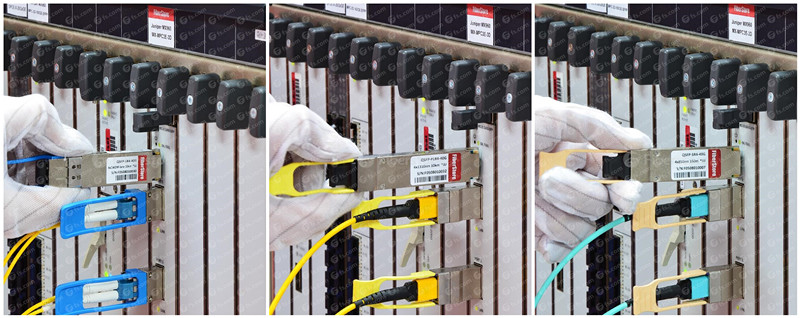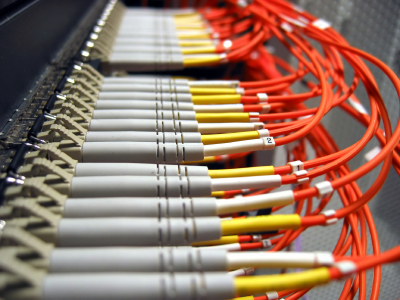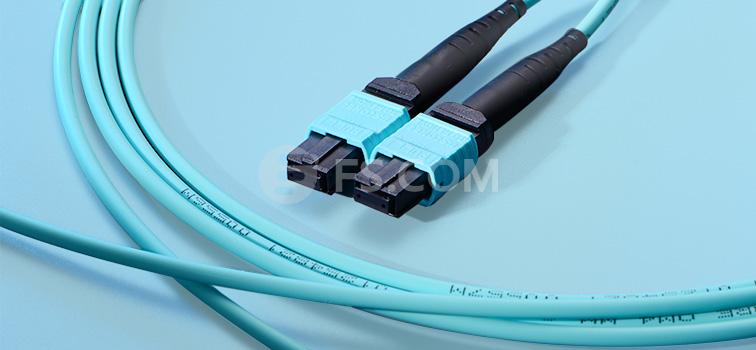As the speed changes from 1 to 10 Gbps and now increases from 10 to 40 Gbps and even 100 Gbps, data centres develop into more complex systems. So different optical technologies and cabling infrastructure are required. For 40G data rates, the special transceiver module is QSFP+ (Quad Small Form-Factor Pluggable Plus). To build 40G data centres, you need to select suitable fibre patch lead for 40G QSFP+ Modules. But how?
40G transmission network needs advanced switch, matched patch leads and transceiver modules. The quality of these connections can largely affect the reliability and stability of the whole 40G network. However, connectivity of 40G is much more complex than ever. Thus, selecting the proper fibre patch cables for 40G network is more difficult and becomes a big issue in 40G migration. As mentioned, QSFP+ transceivers are suggested for 40G, this article will provide as detailed as possible about fibre patch lead selection for 40G QSFP+ transceivers.

Patch cable is very important to 40G network not only because the switch connections necessity, but also because of the transmission principle of the fibre optic signals and the high density trend of 40G transmission. Several important factors like cable, connector and switch port should be taken into account when selecting patch leads for 40G QSFP+ transceivers.
Single-mode or Multimode Fibre Patch Lead
Fibre patch lead is essential for the network performance. Optical signals perform differently when information transforms through the cables with different wavelengths. When people buy fibre optical patch leads for 40G QSFP+ transceiver, they often ask if a 40GBASE universal QSFP+ transceiver working on wavelength of 850nm can be used with OM1 patch leads. The answer is yes, but not suggested. Why? As the optical signal transmission distance gets shorter, the data rate increases. The transmission distance and quality would be limited by using OM1 optical cable with 40G QSFP+ transceiver. OM1 cable is only suggested for 100 Mb/s and 1000Mb/s transmission. Two upgraded cables—OM3 and OM4 are suggested for 40G QSFP+ transceivers in short distance.
IEEE has announced standards for 40G transmission in both long distance and short distance, which are 40GBASE-LR4 and 40GBASE-SR4. (LR stands for long reach and SR stands for short-reach and). For long reach, single-mode fibre is suggested for 40G transmission with the distance up to 10 km. For short reach, multimode fibre—OM3 (up to 100 metres) and OM4 (up to 150 metres) is suggested for 40G transmission. OM3 and OM4, which are usually aqua-coloured, are accepted economic solutions for 40G in short distance with lower insertion loss and higher bandwidth.
MTP or LC Fibre Patch Lead
The connector type of the patch leads should depend on the interface of 40G QSFP+ transceiver. Now there are two interfaces commonly adopted by 40G QSFP+ transceiver and they are MTP and LC. Usually 40G QSFP+ transceiver with MPO interface is designed for short transmission distance and LC for long transmission distance. However, several 40G QSFP+ transceivers like 40GBASE-PLR4 and 40GBASE-PLRL4 have MPO interfaces to support long transmission distance.

High density is the most obvious characteristic of 40G transmission, which is largely reflected in the MTP connectors on patch leads used with 40G QSFP+ transceiver. As QSFP+ transceiver uses four 10G channels, MTP cable which uses 4 pairs of fibres with can provide a time-save and stable solution for 40G QSFP+ transceivers.
Besides, 40G QSFP+ transceiver with LC interface is also available. This type of QSFP transceiver uses four lanes with each carrying 10G in 1310nm window multiplexed to achieve 40G transmission. For this type, patch cable with duplex LC connector should be used.
Switch Port
The importance of network flexibility gradually reveals as the speed of Ethernet increases. Cabling options for 40G network are 40G QSFP+ to 40G QSFP+, 40G QSFP+ to SFP+. It’s very common that 40G ports is needed to be connected with 10G port. In this case, fan out patch cable with MTP connector on one end and four LC duplex connectors on the other end is suggested.
Factors like single-mode or multimode fibre jumpers, fibre patch lead connector and switch port are important in selecting the right patch leads for 40G QSFP+ transceivers. They are closely related to the transmission distance, network flexibility and reliability of the whole 40G network. But in practical cabling for 40G QSFP+ transceivers, there are more need to be considered. Planning and designing takes a lot of time and may not achieve results good enough. However, FS.COM can solve your problems with professional one-stop service including the cost-effective and reliable network designing and 40G products.



